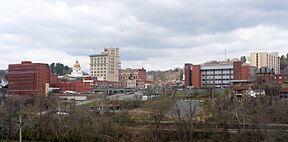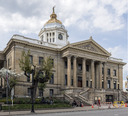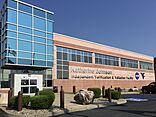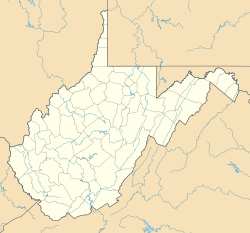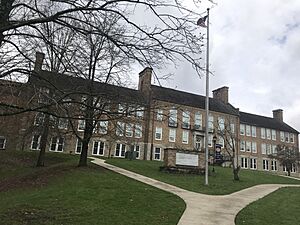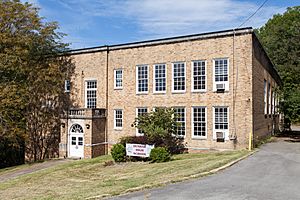Fairmont, West Virginia facts for kids
Quick facts for kids
Fairmont, West Virginia
|
|||||
|---|---|---|---|---|---|
|
|
|||||
|
|||||
| Nickname(s):
Friendly City
|
|||||
| Motto(s):
"Spend a Day... Spend a Lifetime"
|
|||||
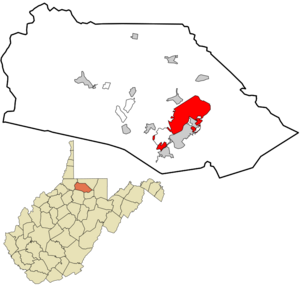
Location of Fairmont in Marion County, West Virginia
|
|||||
| Country | |||||
| State | |||||
| County | Marion | ||||
| Settled | 1819 | ||||
| Incorporated (town) | 1820 | ||||
| Incorporated (city) | 1899 | ||||
| Founded by | Boaz Fleming | ||||
| Named for | The town's overlook of the Monongahela River | ||||
| Government | |||||
| • Type | Council-manager government | ||||
| Area | |||||
| • Total | 8.99 sq mi (23.27 km2) | ||||
| • Land | 8.60 sq mi (22.28 km2) | ||||
| • Water | 0.38 sq mi (0.99 km2) | ||||
| Elevation | 984 ft (300 m) | ||||
| Population
(2020)
|
|||||
| • Total | 18,313 | ||||
| • Estimate
(2021)
|
18,209 | ||||
| • Density | 2,137.64/sq mi (825.36/km2) | ||||
| Time zone | UTC−5 (Eastern (EST)) | ||||
| • Summer (DST) | UTC−4 (EDT) | ||||
| ZIP codes |
26554-26555
|
||||
| Area code(s) | 304 | ||||
| FIPS code | 54-26452 | ||||
| GNIS feature ID | 1560581 | ||||
Fairmont is a city in West Virginia, United States. It is the main town in Marion County. In 2020, about 18,313 people lived there. This makes it the eighth-largest city in the state. Fairmont is also the center of a larger area called the Fairmont micropolitan area. This area includes all of Marion County.
Contents
History of Fairmont
How Fairmont Started
In the 1700s, the first small farms and homes were built in the area that is now Fairmont. People mostly grew their own food to live.
In 1789, a Revolutionary War soldier named Boaz Fleming moved to western Virginia. He bought a large farm of 254 acres. In 1808, Fleming traveled to Clarksburg to pay taxes. While there, he met his cousin, Dolley Madison. She was the wife of President James Madison.
Fleming told Mrs. Madison that he had to travel over 100 miles each year to pay taxes. Mrs. Madison suggested he create his own county to make things easier. In 1814, Fleming started a petition to do just that. He wanted to name the new county Madison County, after Dolley and James Madison.
The only town in Fleming's proposed county was Milford, which is now Rivesville. Fleming wanted Milford to be the main town for Madison County. However, the people of Milford wanted to stay part of Monongalia County. So, Fleming's plan did not get enough support.
Fleming then decided to create a new town near his farm. His farm was on the west side of the Monongahela River. In 1817, Fleming's sons, William and David, started clearing land on their father's farm. This land would later become downtown Fairmont.
Fairmont's Modern Story
In 1819, the town was founded as Middletown, Virginia. It was called Middletown because it was halfway between Morgantown and Clarksburg. A road was built between these two cities in the same year. Fleming's new town became a good resting spot for travelers. The town officially became Middletown on January 19, 1820.
The current borders of Marion County were set in 1842. Middletown was chosen as the county's main town. At that time, William Haymond Jr. suggested changing the town's name to Fairmont. He thought the town had a beautiful view of the Monongahela River, like a "fair mount." The town was officially named Fairmont in 1843.
During the American Civil War in 1863, Confederate General William E. Jones and his soldiers raided Fairmont. They cut off Union supply lines to get food and horses. They also burned books from the personal library of Governor Francis Harrison Pierpont.
Many of the first buildings in Fairmont were not built very well. By 1852, only about 30 years after the city was founded, many parts of Fairmont were falling apart. Reports from 1873 showed that these buildings were still in bad shape. On April 2, 1876, a big fire destroyed much of the city's business area and many homes. The poor condition of the buildings might have made the fire worse. Also, many coal mines under Fairmont may have played a role.
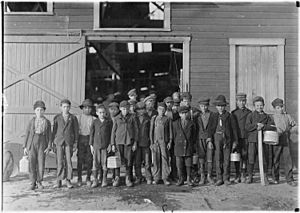
Between 1891 and 1901, Fairmont's population grew from 1,000 to 7,000 people. The City of Fairmont was officially chartered in 1899. This meant it took in the nearby towns of Palatine (also called East Side) and West Fairmont. By 1901, Fairmont was an important center for business. Many railroads passed through the city, including the Baltimore and Ohio Railroad.
Fairmont also became the main center for the coal trade in northern West Virginia. About 10,000 workers were employed in the coal mines around Fairmont.
By 1978, Fairmont started having problems with its land sinking. This was because the old 19th-century coal mines under the city were crumbling. Over the next few years, the government spent money to fix this sinking problem. This helped prevent damage to the town.
Fairmont's Geography and Climate

The Tygart Valley River and the West Fork River meet in Fairmont to form the Monongahela River. Buffalo Creek, which flows into the Monongahela River, also runs through the northern part of the city.
Fairmont covers a total area of about 9 square miles (23.27 square kilometers). Most of this area is land, and a small part is water.
Fairmont's Weather
Fairmont has a humid continental climate. This means it has very warm summers and cold, freezing winters. However, during winter, warm air from the Gulf of Mexico can sometimes make temperatures rise above 50°F (10°C). This happens about six times in January and more often in December and February.
Sometimes, very cold air from Canada moves into West Virginia. This can cause temperatures to drop below 0°F (-18°C). This happens about three mornings each winter. The coldest month on record was January 1977, with an average temperature of 16.0°F (-8.9°C).
Even though it rains a lot throughout the year, most of the winter precipitation is rain, not snow. This is because cold air is usually drier. The most snow in one month was 46.5 inches (1.18 meters) in November 1950. The most snow in one season was 77.4 inches (1.97 meters) between July 1950 and June 1951. The least snow in a season was 12.0 inches (0.30 meters) between July 1918 and June 1919.
The wettest year was 1956, with 58.12 inches (1476 mm) of rain. The driest year was 1930, with 26.25 inches (667 mm) of rain. The hottest temperature ever recorded was 108°F (42°C) on August 8, 1918. The coldest temperature was -21°F (-29°C) on January 21, 1994.
| Climate data for Fairmont, West Virginia (1991–2020 normals; extremes 1905–present) | |||||||||||||
|---|---|---|---|---|---|---|---|---|---|---|---|---|---|
| Month | Jan | Feb | Mar | Apr | May | Jun | Jul | Aug | Sep | Oct | Nov | Dec | Year |
| Record high °F (°C) | 81 (27) |
79 (26) |
91 (33) |
95 (35) |
100 (38) |
103 (39) |
105 (41) |
108 (42) |
101 (38) |
93 (34) |
84 (29) |
75 (24) |
108 (42) |
| Mean daily maximum °F (°C) | 39.6 (4.2) |
43.0 (6.1) |
52.4 (11.3) |
65.4 (18.6) |
73.4 (23.0) |
80.2 (26.8) |
83.6 (28.7) |
82.6 (28.1) |
77.1 (25.1) |
65.3 (18.5) |
53.8 (12.1) |
43.6 (6.4) |
63.3 (17.4) |
| Daily mean °F (°C) | 31.8 (−0.1) |
34.3 (1.3) |
42.5 (5.8) |
53.9 (12.2) |
62.5 (16.9) |
70.0 (21.1) |
73.6 (23.1) |
72.6 (22.6) |
66.4 (19.1) |
54.9 (12.7) |
44.7 (7.1) |
36.1 (2.3) |
53.6 (12.0) |
| Mean daily minimum °F (°C) | 24.0 (−4.4) |
25.5 (−3.6) |
32.6 (0.3) |
42.4 (5.8) |
51.6 (10.9) |
59.8 (15.4) |
63.7 (17.6) |
62.5 (16.9) |
55.8 (13.2) |
44.5 (6.9) |
35.5 (1.9) |
28.7 (−1.8) |
43.9 (6.6) |
| Record low °F (°C) | −21 (−29) |
−12 (−24) |
−10 (−23) |
10 (−12) |
24 (−4) |
35 (2) |
42 (6) |
36 (2) |
29 (−2) |
17 (−8) |
1 (−17) |
−16 (−27) |
−21 (−29) |
| Average precipitation inches (mm) | 3.81 (97) |
3.22 (82) |
4.21 (107) |
3.90 (99) |
5.09 (129) |
4.67 (119) |
4.91 (125) |
3.80 (97) |
3.85 (98) |
3.43 (87) |
3.15 (80) |
3.73 (95) |
47.77 (1,213) |
| Average snowfall inches (cm) | 13.5 (34) |
9.1 (23) |
4.8 (12) |
1.0 (2.5) |
0.0 (0.0) |
0.0 (0.0) |
0.0 (0.0) |
0.0 (0.0) |
0.0 (0.0) |
0.2 (0.51) |
1.8 (4.6) |
7.4 (19) |
37.8 (96) |
| Average precipitation days (≥ 0.01 in) | 15.0 | 12.8 | 12.7 | 13.5 | 14.4 | 12.1 | 12.1 | 10.4 | 9.9 | 10.5 | 10.7 | 13.6 | 147.7 |
| Average snowy days (≥ 0.1 in) | 6.9 | 4.9 | 2.4 | 0.5 | 0.0 | 0.0 | 0.0 | 0.0 | 0.0 | 0.0 | 1.2 | 4.4 | 20.3 |
| Source: NOAA (snow 1981–2010) | |||||||||||||
People of Fairmont: Demographics
| Historical population | |||
|---|---|---|---|
| Census | Pop. | %± | |
| 1850 | 683 | — | |
| 1860 | 704 | 3.1% | |
| 1870 | 621 | −11.8% | |
| 1880 | 900 | 44.9% | |
| 1890 | 1,023 | 13.7% | |
| 1900 | 5,655 | 452.8% | |
| 1910 | 9,711 | 71.7% | |
| 1920 | 17,851 | 83.8% | |
| 1930 | 23,159 | 29.7% | |
| 1940 | 23,105 | −0.2% | |
| 1950 | 29,346 | 27.0% | |
| 1960 | 27,477 | −6.4% | |
| 1970 | 26,093 | −5.0% | |
| 1980 | 23,863 | −8.5% | |
| 1990 | 20,210 | −15.3% | |
| 2000 | 19,097 | −5.5% | |
| 2010 | 18,704 | −2.1% | |
| 2020 | 18,416 | −1.5% | |
| 2021 (est.) | 18,209 | −2.6% | |
| U.S. Decennial Census | |||
Fairmont's Population in 2020
In the 2020 census, there were 18,416 people living in Fairmont. There were 7,903 households. A household is a group of people living in one home.
Most people in the city, about 84.2%, were White. About 7.3% were African American, and 0.6% were Asian. About 0.3% were Native American. Some people, 0.5%, were from other races, and 7% were from two or more races. People of Hispanic or Latino background made up 2.2% of the population.
In the households, 37.1% were married couples. About 30.6% had a female head of household with no spouse. About 23% had a male head of household with no spouse. The average size of a household was 2.83 people. The average age in the city was 34.4 years. About 18.3% of the city's population was under 18 years old. The average household income was $47,618. About 19.9% of the people lived in poverty.
Arts and Culture in Fairmont
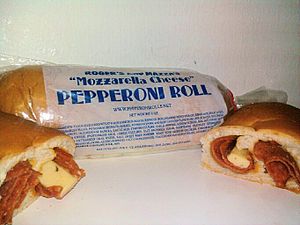
Fairmont is home to Country Club Bakery. This is where the famous pepperoni roll snack was first created! The bakery still sells these rolls and other tasty baked goods. Fairmont is proud to call itself the "pepperoni roll capital of the world."
The city also has offices for several national agencies. The National White Collar Crime Center in Fairmont helps law enforcement across the country. They work to prevent, investigate, and stop financial and high-tech crimes.
The NASA Katherine Johnson Independent Verification and Validation Facility is also in Fairmont. It is part of the Goddard Space Flight Center. More than 150 full-time employees work there. They also have over 20 partners and contractors.
The NOAA Robert H. Mollohan Research Facility is located here too. This facility gets weather data from satellites. It has more than 100 full-time employees.
Education in Fairmont
Fairmont has several important schools. Fairmont Senior High School is a public high school. It is listed on the National Register of Historic Places because of its historical importance. The school was first started in the late 1800s. It moved to new locations in 1905 and 1928. The current school building was designed by architect William B. Ittner.
Fairmont State University is a public university in the city. About 3,800 students attend this university. It offers many different degrees. Students can earn master's degrees in business, education, teaching, criminal justice, and nursing. The university also offers 90 bachelor's degrees and 50 associate degrees.
The college first started as a school for teachers. It was called Fairmont Normal School. It was located on the corner of Fairmont Avenue and Second Street. The school moved to its current location in 1917.
Dunbar School is another historic building in Fairmont. It used to be a high school only for Black students. The architect William B. Ittner also designed this school. It was built in 1928.
Fairmont's Transportation and Roads
Major Highways in Fairmont
Fairmont is in the North-Central part of West Virginia. It is located along West Virginia's I-79 High Tech Corridor. Here are the main highways that go through Fairmont:
 Interstate 79
Interstate 79 U.S. Highway 19
U.S. Highway 19 U.S. Highway 250
U.S. Highway 250 West Virginia Route 310
West Virginia Route 310 West Virginia Route 273
West Virginia Route 273
Airports Near Fairmont
The Fairmont Municipal Airport (also known as Frankman Field) is a public airport. It is located about two nautical miles (4 kilometers) southwest of downtown Fairmont. The Fairmont-Marion County Regional Airport Authority owns and operates this airport.
Famous People from Fairmont
Many notable people have connections to Fairmont, West Virginia. Here are a few:
- Tony Adamle, a football player.
- Max Balchowsky, a famous race car builder and driver from the 1950s and 1960s.
- David Carpenter, a professional baseball player.
- Joe Cerisano, a singer, songwriter, and musician. He sang "Be All That You Can Be."
- Ann K. Covington, the first woman to be chief justice of the Supreme Court of Missouri.
- Frank Kendall Everest Jr., a U.S. Air Force officer and test pilot. He was once called the "Fastest Man Alive."
- Aretas B. Fleming, who was the 8th Governor of West Virginia.
- Johnnie Johnson, a piano player and blues musician. He is in the Rock and Roll Hall of Fame.
- John Knowles, the author of the famous book A Separate Peace.
- Alan Mollohan, a U.S. Representative from West Virginia.
- Francis H. Pierpont, who was Governor of parts of Virginia during the American Civil War. He is known as the "father of West Virginia."
- Mary Lou Retton, a gymnast and 1984 Olympic gold medalist.
- Nick Saban, a well-known college football head coach. He was born in Fairmont.
- Hershel W. Williams, who received the Medal of Honor during the Battle of Iwo Jima.
Images for kids
-
Child laborers at Monougal Glass Works in Fairmont, 1908. Photo by Lewis Hine.
-
Downtown Fairmont viewed from across the Monongahela River
-
The pepperoni roll snack originated in Fairmont's Country Club Bakery
See also
 In Spanish: Fairmont (Virginia Occidental) para niños
In Spanish: Fairmont (Virginia Occidental) para niños


